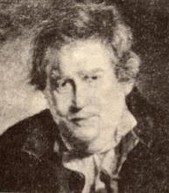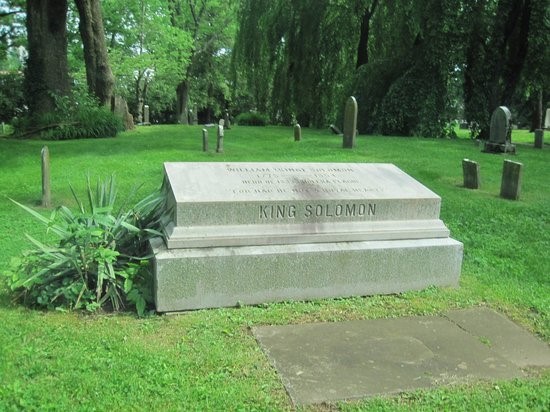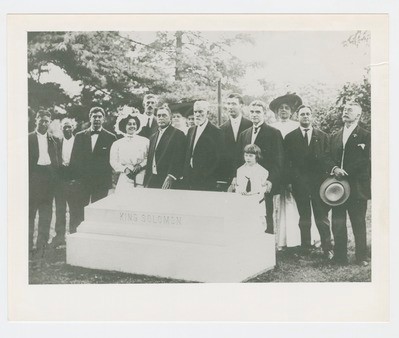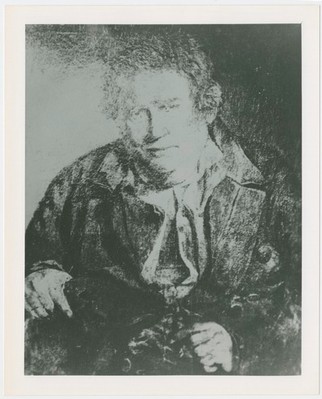“King” William Solomon (1775-1854)
Introduction
Author-Uploaded Audio
Listen to a narration of this entry's description by Victoria Endres.
Text-to-speech Audio
Images
William "King" Solomon (1)

Grave site (2)

Memorial service for William (3)

Painting of William (4)

Backstory and Context
Author-Uploaded Audio
Listen to a narration of this entry's description by Victoria Endres.
Text-to-speech Audio
Born to a well to do family in Virginia, William Solomon was a character made for a sitcom. [1] Growing up in the same area as Henry Clay, William would tell people that the two grew up and played together. Because of this often repeated story, he was a devout Whig voting for Clay in all Lexington elections. Even in the face of a liquid bribe, he held firm to his allegiance to Clay.[1]
To become King was a feat, the story goes,
"The owner of a leading dry goods store has Solomon to trim the branches outside the main door of his establishment. Solomon got right to work, but later took a whiskey break. He returned to work after a few too many, climbed up the tree and began sawing on a big limb. Sadly, he had been sawing the limb he was sitting on. He picked himself up and brushed the dirt off and went back to work. But people watching agreed that only a man as wise as King Solomon in the bible could have managed a stunt like that."[1]
Following repeated arrest, the city of Lexington felt William needed to be taught a lesson that no jail could. He was sold as a servant to "Aunt" Charlotte for $13 for a term of 9 months.[2]
The origin of vagrancy laws comes from post Black Plague England.[4] Their purpose was to ensure there was an adequate labor supply with a large portion of their population gone following the plague.[4] Their intent was to encourage people to find a job so they were not arrested or they would be forced to work while jailed.[4] When these laws made their way to the U.S. their purpose did not translate well as they just resulted in the arrest of the homeless. "Kings" punishment fit the purpose of the laws; make him work and he will no longer be a drunk, sleeping in the streets.
“Aunt Charlotte was a slave brought to Lexington, KY, in the late 1700s. She was freed and inherited property after her owners died. She supported herself by selling fruit and baked goods at the open market.”[2] Slavery in Kentucky was unique in comparison to the rest of the country. The image the state portrays is that slavery here was a "milder" form than what was found in other southern states which unfortunately was not true.[3] Slavery had been present since the frontier days and persisted to the completion of the Civil War. The origin of this misnomer comes from the fact that at the time of the Civil War the state was split in its allegiances to the Union and Confederate armies.[3] As a free slave Charlotte still had limited rights and opportunity for growth; despite these limiting realities she still had a prosperous life as a small business owner.
Her purchased servant, William Solomon, gains his Lexington fame in 1833 at the height of the Cholera epidemic. As the town drunk he was an unlikely hero, but what made him the town drunk also made him perfect for the job: whisky. Despite irreparable liver damage, Solomon not drinking the towns water was his saving grace. "Lexington's porous underground system of limestone caves and sinkholes leaves the area with a low-quality water that is dangerous enough on its own."[6] The danger was heightened by the further contamination caused by a recent flood. [6] “With no organized waste collection, the waste of households and manufacturers was tossed into the streets. Outdoor privies overflowed during flooding," and all of these "health risks" were lifted from the streets and Drained back into the wells, At the time of the outbreak drinking well water was a sure death sentence.[6] This reality of the time meant that most drank whisky and bourbon in place of water and it was completely normal.[6] "King" just had the misfortune of being homeless and drinking repeatedly until he passed out.
"Aunt" Charlotte was not as fortunate as Solomon. She did not survive the outbreak. With bodies piling up, William Solomon alongside London Ferrell and Jefferson Davis buried the remaining bodies in the Old Episcopal Burying Ground. Doing so prevented the further spread of the disease; for his efforts, in 1854 he was honored with a memorial in the Lexington Cemetery.
The current Lexington cemetery is not the original site closer to the town center, as “people were realizing that family graveyards on farms and even in the town itself were not satisfactory, for property often was sold. Too, there was growing concern that burial of the dead in town created a menace to public health, contaminating wells and springs.” [7] Therefore, there was a necessity to find a new place for Lexington’s dead. The new cemetery was to be built to look like a park, a “garden Cemetery” [7]. Visitors can drive through the entire park and see that no group of headstones look the same. It was designed by Charles S. Bell and John Lutz and its creation alleviated the stress of the numerous bodies piling up on church and family plots that could not handle them. Additionally, there was a citywide effort to ensure that none of the land set aside to for the cemetery overlapped with the water system.
Through his monument in Lexington Cemetery and his colorful history, "King" will live on in the hearts of the Lexington community as their unlikely hero in a time of tragedy.
Sources
1.Solomon, William "King", Accessed November 25th 2019. http://lexhistory.org/wikilex/solomon-william-king.
2.“Aunt Charlotte and King Solomon,” Notable Kentucky African Americans Database, accessed December 3, 2019, c.
3.Gerald, Smith. “Slavery in Kentucky.” Lecture, Lexington, October 23, 2018.
4.Yeamans, Robin. "Constitutional Attacks on Vagrancy Laws." Stanford Law Review 20, no. 4 (1968): 782-93.
5."Glimpses of Slavery--Southern Testimony." The Friend; a Religious and Literary Journal (1827-1906) 21, no. 25 (1848): 195.
6.Truman, Cheryl . “Lexington's 1833 Cholera Epidemic Chronicled in New Book,” Lexington Herald Leader. October 27th 2014. Accessed December 7th 2019. https://www.kentucky.com/news/health-and-medicine/article44518221.html.
7.Milward, Burton . Chapter 2: The Founding of the Cemetery., The Lexington Cemetery . Accessed December 7th 2019. http://www.lexcem.org/index.php/2012-12-26-14-45-57/cemetery-history?id=255.
Solomon, William "King", Accessed November 25th 2019. http://lexhistory.org/wikilex/solomon-william-king.
https://www.jpinews.com/2017/09/01/my-kentucky-solomon-and-charlotte-an-unlikely-partnership/
https://exploreuk.uky.edu/catalog/xt75736m317q_107_1?q=William+Solomon+&f%5Bsource_s%5D%5B%5D=Lexington%2C+Kentucky+photograph+albums&per_page=20
https://exploreuk.uky.edu/catalog/xt75736m317q_105_1?q=William+Solomon+&f%5Bsource_s%5D%5B%5D=Lexington%2C+Kentucky+photograph+albums&per_page=20
